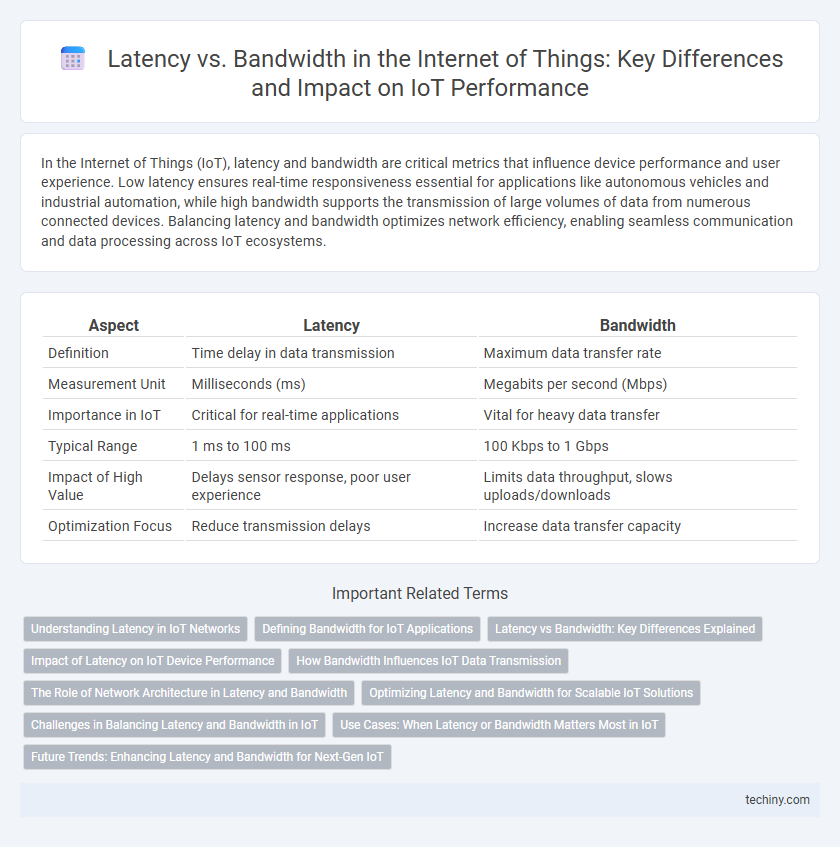In the Internet of Things (IoT), latency and bandwidth are critical metrics that influence device performance and user experience. Low latency ensures real-time responsiveness essential for applications like autonomous vehicles and industrial automation, while high bandwidth supports the transmission of large volumes of data from numerous connected devices. Balancing latency and bandwidth optimizes network efficiency, enabling seamless communication and data processing across IoT ecosystems.
Table of Comparison
| Aspect | Latency | Bandwidth |
|---|---|---|
| Definition | Time delay in data transmission | Maximum data transfer rate |
| Measurement Unit | Milliseconds (ms) | Megabits per second (Mbps) |
| Importance in IoT | Critical for real-time applications | Vital for heavy data transfer |
| Typical Range | 1 ms to 100 ms | 100 Kbps to 1 Gbps |
| Impact of High Value | Delays sensor response, poor user experience | Limits data throughput, slows uploads/downloads |
| Optimization Focus | Reduce transmission delays | Increase data transfer capacity |
Understanding Latency in IoT Networks
Latency in IoT networks refers to the delay between data transmission and reception, critical for time-sensitive applications like autonomous vehicles and industrial automation. Low latency ensures real-time communication and rapid decision-making, while high latency can cause data loss or system failures. Understanding latency characteristics helps optimize network performance, balancing speed and reliability without necessarily increasing bandwidth.
Defining Bandwidth for IoT Applications
Bandwidth in IoT applications refers to the maximum data transfer rate that a network can handle, directly impacting the volume of sensor data transmitted within a given time frame. Higher bandwidth enables efficient handling of large-scale IoT deployments with numerous connected devices generating continuous data streams. Optimizing bandwidth ensures timely data exchange, critical for real-time monitoring, control systems, and seamless integration across varied IoT ecosystems.
Latency vs Bandwidth: Key Differences Explained
Latency measures the delay before data transfer begins following an instruction, while bandwidth defines the maximum rate of data transfer over a network. In Internet of Things (IoT) systems, low latency ensures real-time responsiveness for critical applications, whereas high bandwidth supports the transmission of large volumes of sensor data. Understanding the trade-offs between latency and bandwidth is essential for optimizing IoT network performance and reliability.
Impact of Latency on IoT Device Performance
Latency directly affects IoT device performance by dictating the speed at which data is processed and actions are executed, crucial for real-time applications such as autonomous vehicles and industrial automation. High latency can cause delays in sensor data transmission, leading to decreased accuracy and responsiveness which impacts system reliability and user experience. In contrast, optimizing latency ensures timely data delivery, enabling efficient decision-making and enhanced functionality in smart cities, healthcare monitoring, and connected home environments.
How Bandwidth Influences IoT Data Transmission
Bandwidth directly impacts IoT data transmission by determining the volume of data that can be sent or received within a given time, enabling real-time analytics and responsive device behavior. High bandwidth supports the simultaneous operation of numerous IoT devices, facilitating seamless streaming of sensor data, firmware updates, and cloud connectivity. Insufficient bandwidth leads to data congestion and packet loss, compromising IoT system reliability and overall performance.
The Role of Network Architecture in Latency and Bandwidth
Network architecture plays a crucial role in balancing latency and bandwidth within Internet of Things (IoT) ecosystems by determining data flow efficiency and processing speed. Edge computing architectures reduce latency by processing data closer to IoT devices, minimizing transmission delays while optimizing bandwidth usage across the network. Hierarchical network designs optimize resource allocation by segregating high-throughput data streams from latency-sensitive control signals, enhancing overall IoT system performance.
Optimizing Latency and Bandwidth for Scalable IoT Solutions
Optimizing latency and bandwidth in scalable IoT solutions requires prioritizing low-latency communication protocols such as MQTT and CoAP to ensure real-time data transmission while managing bandwidth efficiently through data compression and edge computing techniques. Implementing adaptive bandwidth allocation and prioritizing critical IoT device traffic reduces network congestion and enhances overall system responsiveness. Leveraging 5G and LPWAN technologies supports high connection density and ultra-reliable low-latency communication, crucial for scalable IoT deployments.
Challenges in Balancing Latency and Bandwidth in IoT
Balancing latency and bandwidth in IoT presents critical challenges due to the diverse requirements of connected devices, where real-time data processing demands ultra-low latency and high bandwidth supports massive data transfers. Network congestion, limited spectrum, and energy constraints further complicate maintaining optimal performance, especially in large-scale deployments like smart cities and industrial automation. Effective management strategies must prioritize adaptive resource allocation and edge computing to minimize latency while maximizing bandwidth utilization.
Use Cases: When Latency or Bandwidth Matters Most in IoT
In industrial automation and autonomous vehicles, low latency is critical to ensure real-time decision-making and safety, as milliseconds can impact operational efficiency and security. Conversely, bandwidth is prioritized in smart city applications and video surveillance, where large volumes of data from sensors and cameras require high-throughput networks for effective monitoring and analysis. Wearable health devices and predictive maintenance systems balance both latency and bandwidth needs depending on the immediacy of alerts and the volume of transmitted data.
Future Trends: Enhancing Latency and Bandwidth for Next-Gen IoT
Emerging IoT technologies emphasize ultra-low latency and high bandwidth to meet the demands of real-time applications such as autonomous vehicles and smart cities. Advancements in 5G and edge computing significantly reduce data transmission delays while increasing throughput, enabling seamless device communication and rapid decision-making. Future trends focus on integrating AI-driven network optimization and advanced modulation techniques to further enhance latency and bandwidth efficiency in next-gen IoT ecosystems.
Latency vs Bandwidth Infographic

 techiny.com
techiny.com